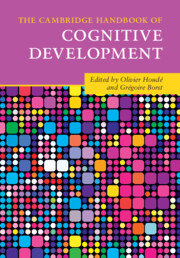Book contents
- The Cambridge Handbook of Cognitive Development
- The Cambridge Handbook of Cognitive Development
- Copyright page
- Contents
- Figures
- Tables
- Contributors
- Introduction
- Part I Neurobiological Constraints and Laws of Cognitive Development
- Part II Fundamentals of Cognitive Development from Infancy to Adolescence and Young Adulthood
- Introduction
- Subpart II.1 Infancy: The Roots of Human Thinking
- Subpart II.2 Childhood and Adolescence: The Development of Human Thinking
- 15 Development of Qualitative Thinking
- 16 Development of Numerical Knowledge
- 17 Numerical Cognition and Executive Functions
- 18 Developing Theory of Mind and Counterfactual Reasoning in Children
- 19 Development of Executive Function Skills in Childhood
- 20 Developing Cognitive Control and Flexible Adaptation during Childhood
- 21 Reasoning Bias and Dual Process Theory
- 22 Social Cognitive Development
- 23 Behavioral and Neural Development of Cognitive Control and Risky Decision-Making across Adolescence
- 24 The Triadic Neural Systems Model through a Machine-Learning Mill
- Part III Education and School-Learning Domains
- Index
- Plate Section (PDF Only)
- References
17 - Numerical Cognition and Executive Functions
Development As Progressive Inhibitory Control of Misleading Visuospatial Dimensions
from Subpart II.2 - Childhood and Adolescence: The Development of Human Thinking
Published online by Cambridge University Press: 24 February 2022
- The Cambridge Handbook of Cognitive Development
- The Cambridge Handbook of Cognitive Development
- Copyright page
- Contents
- Figures
- Tables
- Contributors
- Introduction
- Part I Neurobiological Constraints and Laws of Cognitive Development
- Part II Fundamentals of Cognitive Development from Infancy to Adolescence and Young Adulthood
- Introduction
- Subpart II.1 Infancy: The Roots of Human Thinking
- Subpart II.2 Childhood and Adolescence: The Development of Human Thinking
- 15 Development of Qualitative Thinking
- 16 Development of Numerical Knowledge
- 17 Numerical Cognition and Executive Functions
- 18 Developing Theory of Mind and Counterfactual Reasoning in Children
- 19 Development of Executive Function Skills in Childhood
- 20 Developing Cognitive Control and Flexible Adaptation during Childhood
- 21 Reasoning Bias and Dual Process Theory
- 22 Social Cognitive Development
- 23 Behavioral and Neural Development of Cognitive Control and Risky Decision-Making across Adolescence
- 24 The Triadic Neural Systems Model through a Machine-Learning Mill
- Part III Education and School-Learning Domains
- Index
- Plate Section (PDF Only)
- References
Summary
Theories have ventured to explain how the human brain has gained the unique ability to develop mathematical concepts and theories. One theory states that mathematics has appeared as a by-product of the human language faculty (Chomsky, 2006). Alternatively, recent cognitive neuroscience research have postulated that mathematics arose from non-linguistic intuitions of numbers and space (Dehaene, 2011; Dillon et al., 2013). Indeed, studies have observed that infants (Starkey & Cooper, 1980; Starkey et al., 1983) and Amazonian indigenous adults with no education in Mathematics and who do not possess number words (Dehaene et al. 2008, Pica et al., 2004) display abstract proto-mathematical intuitions of arithmetic and geometry. These ‘core knowledges’ (Spelke & Kinzler, 2007) have been theorized to be the ontological building blocks that scaffold our ability for representing numbers symbolically and performing exact arithmetic (Starr et al., 2013). They have been found to be predictive of later, more complex mathematical abilities (Gilmore et al., 2010; Halberda et al., 2008; Starr et al., 2013), supporting the idea that complex mathematics would arise from core representations of number and space (Amalric & Dehaene, 2016). Extensive research has shown that numerical and spatial cognition were tightly connected (Hubbard et al., 2005). In some contexts, this relation between number and visuospatial dimensions, such as spatial extent or density, can lead to interferences which can hinder the development of math abilities.
- Type
- Chapter
- Information
- The Cambridge Handbook of Cognitive Development , pp. 383 - 407Publisher: Cambridge University PressPrint publication year: 2022



